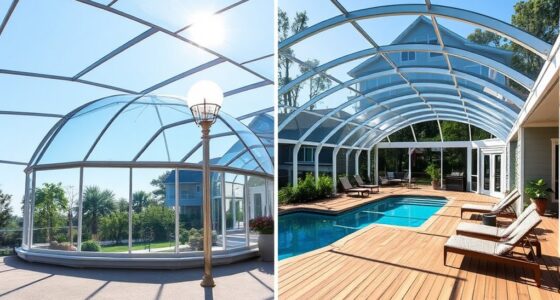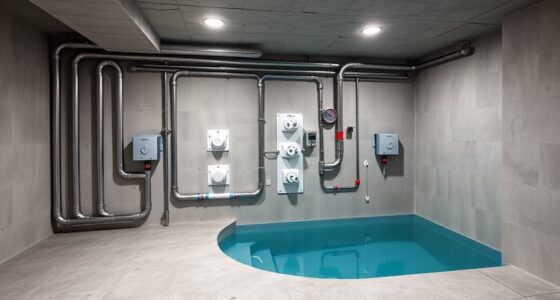To control noise and vibrations from swim currents, you should consider installing specialized acoustic insulation around the system to absorb sound waves and reduce airborne noise. Incorporating structural damping materials like resilient mounts or damping pads helps prevent vibrations from resonating through the building structure. Combining these strategies ensures a peaceful environment, protects your facility’s integrity, and enhances user comfort. Keep exploring how these techniques work together for ideal results and long-term benefits.
Key Takeaways
- Implement acoustic insulation materials around swim current systems to reduce airborne noise transmission.
- Use structural damping devices like resilient mounts and damping pads to absorb vibrations from high flow rates.
- Analyze sound wave patterns to target specific noise sources for more effective control measures.
- Combine soundproofing and vibration damping techniques for comprehensive noise and vibration mitigation.
- Regular maintenance and strategic material selection ensure long-term noise reduction and structural integrity.

Controlling noise and vibrations from swim currents is essential to guarantee a comfortable and safe environment for swimmers and nearby occupants. When dealing with powerful water flows, noise can quickly become intrusive, disrupting relaxation and concentration. Vibrations generated by the currents can also resonate through the structure, leading to discomfort and potential long-term damage. Implementing effective noise and vibration control measures ensures that these issues are minimized, maintaining a peaceful atmosphere and protecting the integrity of the facility.
Effective noise and vibration control from swim currents ensures a safe, peaceful aquatic environment.
One of the most effective strategies involves the use of acoustic insulation. By installing specialized materials around the swim current systems, you can substantially reduce the transmission of sound waves. Acoustic insulation works by absorbing sound energy, preventing it from propagating through walls, ceilings, and other structural elements. This approach not only diminishes the overall noise level but also curtails sound reverberation within the space, creating a more tranquil environment. When selecting insulation materials, prioritize those with high sound absorption coefficients and durability suited to humid, aquatic settings. Proper installation is essential; gaps or improperly sealed areas can undermine the insulation’s effectiveness.
In addition to acoustic insulation, structural damping plays a critical role in managing vibrations. Structural damping involves incorporating materials or devices that absorb vibrational energy, preventing it from passing through the building’s framework. This can include resilient mounts, damping pads, or specialized damping compounds applied to key structural components. By integrating these solutions, you help dissipate the vibrational energy generated by the swim currents, reducing the risk of noise transmission and structural fatigue. Properly designed damping systems are especially important in large aquatic facilities, where high flow rates can produce substantial vibrations that, if unchecked, may lead to noise pollution or even structural deterioration over time.
Furthermore, understanding the behavior of sound waves and vibration patterns allows for better targeted interventions, enhancing the overall effectiveness of control measures. Combining acoustic insulation with structural damping offers a comprehensive approach to noise and vibration control. While acoustic insulation targets airborne sound, damping addresses the physical vibrations that produce noise and structural stress. Together, these methods create a more effective barrier against disturbances caused by swim currents. By investing in quality materials and precise installation, you guarantee that the aquatic environment remains comfortable and safe for everyone. This holistic approach not only improves user experience but also prolongs the lifespan of the facility, making it a worthwhile investment in the long run. Overall, controlling noise and vibrations through these targeted measures allows you to maintain a serene, well-functioning aquatic space.
Frequently Asked Questions
How Do Swim Currents Impact Aquatic Life?
Swim currents can considerably impact aquatic life by disrupting marine habitats and altering fish behavior. You might notice fish struggling to navigate or find food, which affects their health and reproduction. Strong currents can erode habitats, making it harder for marine species to thrive. As a result, these changes can lead to decreased biodiversity and imbalance in the ecosystem. Understanding these impacts helps you appreciate the importance of managing swim currents responsibly.
What Materials Are Most Effective for Noise Absorption?
You want to silence that relentless hum, don’t you? Acoustic panels are your best bet, as they absorb sound waves effectively and reduce echo. Soundproof barriers, made from dense, specialized materials, block noise transmission entirely. Together, these materials create a quiet haven around swim currents, ensuring minimal disturbance. When chosen wisely, they turn chaos into calm, giving you control over noise levels and a peaceful aquatic environment.
Can Vibration Control Methods Affect Water Quality?
Vibration control methods, like vibration damping, can influence water quality by reducing tank acoustics-related vibrations that might disturb water flow. When you implement effective damping, it minimizes noise and vibrations transmitted through the tank structure, helping maintain clearer water and preventing disturbances. Properly designed vibration control not only improves comfort but also ensures that water quality stays high by preventing vibrations from causing unwanted mixing or turbulence.
Are There Eco-Friendly Solutions for Noise Reduction?
You can’t make an omelet without breaking eggs, and eco-friendly noise reduction offers sustainable options. Using biodegradable barriers and natural soundproofing materials helps reduce noise without harming the environment. These solutions are safe, renewable, and effective, making them ideal for eco-conscious projects. By choosing such methods, you’re not only lowering noise pollution but also supporting eco-friendly practices that benefit both the environment and your community.
How Does Climate Change Influence Swim Current Noise Levels?
Climate change increases swim current noise levels by causing more extreme weather events and shifting water patterns, which challenge noise mitigation efforts. You’ll need to prioritize climate adaptation strategies that address these changing conditions to maintain effective noise control. By integrating eco-friendly solutions, such as natural barriers and sustainable materials, you can better manage noise levels and support overall environmental health while adapting to these new challenges.
Conclusion
By mastering noise and vibration control for swim currents, you could turn your pool into a sanctuary so peaceful, even the loudest thunderstorms would seem like a whisper. Imagine a space where every splash and swirl is silent as the stars, and the roar of your currents is tamed to a gentle hum. With these techniques, you’re not just controlling noise—you’re creating an oasis so serene, it could silence the chaos of the world itself.









